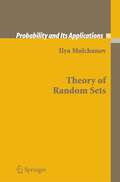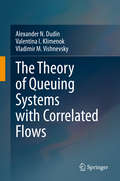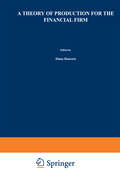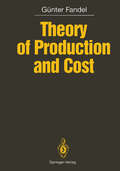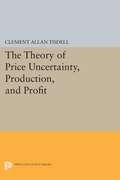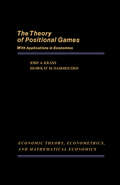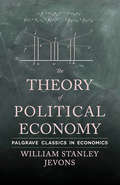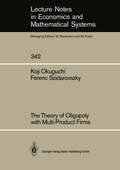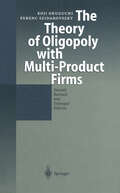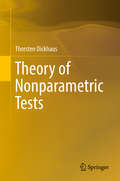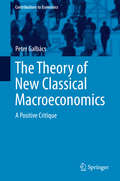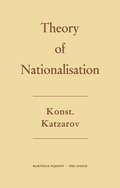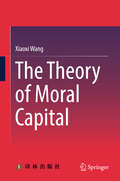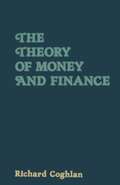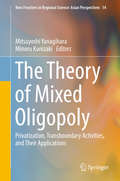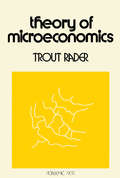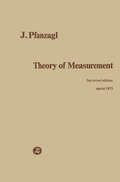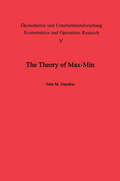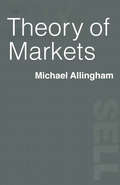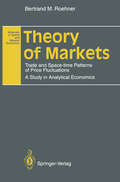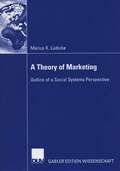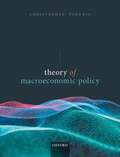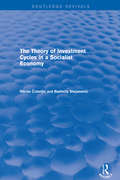- Table View
- List View
Theory of Random Sets (Probability and Its Applications)
by Ilya MolchanovThis is the first systematic exposition of random sets theory since Matheron (1975), with full proofs, exhaustive bibliographies and literature notes Interdisciplinary connections and applications of random sets are emphasized throughout the bookAn extensive bibliography in the book is available on the Web at http://liinwww.ira.uka.de/bibliography/math/random.closed.sets.html, and is accompanied by a search engine
The Theory of Queuing Systems with Correlated Flows
by Alexander N. Dudin Valentina I. Klimenok Vladimir M. VishnevskyThis book is dedicated to the systematization and development of models, methods, and algorithms for queuing systems with correlated arrivals. After first setting up the basic tools needed for the study of queuing theory, the authors concentrate on complicated systems: multi-server systems with phase type distribution of service time or single-server queues with arbitrary distribution of service time or semi-Markovian service. They pay special attention to practically important retrial queues, tandem queues, and queues with unreliable servers. Mathematical models of networks and queuing systems are widely used for the study and optimization of various technical, physical, economic, industrial, and administrative systems, and this book will be valuable for researchers, graduate students, and practitioners in these domains.
A Theory of Production for the Financial Firm (Innovations in Financial Markets and Institutions #4)
by Diana HancockFurthermore, if the effects of regulations on user costs are excluded, it is impossible to analyze monetary policy effects. Chapter 2 examines the principal areas of regulation that affect user costs. For example, reserve requirements, as administered by the Federal Reserve, act as a tax on financial firms so covered. Required reserves earn no return to the financial firm and there is foregone revenue. Deposit insurance increases the user cost of servicing deposits to the banks. Interest rate regulations place limits on interest rates on time de posits, or prohibit payments on demand deposits during part of the period studied. Underlying all these are the open market operations of the Federal Reserve, and their effects on interest rates and the quantities of financial goods. Chapter 2 reveals that previous work on the estimation of bank tech nologies is incomplete, and that the regulations require modelling as a part of the profit maximizing structure. 1.3 User Cost Derivation Chapter 3 discusses the construction of user costs. These are derived for the services from all assets or liabilities on a bank balance sheet or appearing on the income statement. The user cost formulation permits goods to be classified as outputs and inputs. Those with a positive user cost, where expenditures per unit exceed revenues per unit, are inputs. The unit for financial goods such as loans or deposits is one dollar per period. Goods with a negative user cost, with expenditures falling below revenue per unit, are outputs.
Theory of Production and Cost
by Günter FandelProduction theory and the theory of cost both belong to the central areas of business administration, for all considerations concerning the economic organization of industrial manufacturing processes start from these. Two developments in the past 30 years have had a considerable influence on the structure and the concentration on points of emphasis in this book. I am referring to findings from KOOPMANS' activity analysis and to the formulation by GUTENBERG of a production function concept that focuses on industrial production processes. Activity analysis has made it possible to develop, from a uniform approach, different types of production functions which describe the concrete principles of production in the productive sector of a business enterprise; this has created a common basis for all production concepts in business administration. The Gutenberg Production Function with its different kinds of adjustment to a changing output has opened up a flexibility to theoretical and practical considerations that gave rise to a large number of additional studies in this area. Considerations in cost theory were in particular need of considerable extensions in the direction of cost minimal combined adjustment processes. By means of the organization of its contents, this book will take both approaches into due account. In that way, it is vastly different from other books dealing with the same subject. As a matter of course, traditional analytical methods and ways of thinking also constitute a large part of the book.
The Theory of Price Uncertainty, Production, and Profit
by Clement Allan TisdellFirms and farmers, under pure competition, must make production decisions in the face of price uncertainty. The author has integrated diverse theories of behavior under uncertainty to provide a new framework for his mathematical analysis of the impact of price uncertainty on the behavior of the firm. Drawing upon the work of Knight, Hicks, von Neumann, and Morgenstern, he develops a schema that accounts for a greater diversity of behavior than do existing theories, yet one which yields simple economic theorems of practical value. The conclusions he draws apply to both socialist and capitalist economics.Originally published in 1968.The Princeton Legacy Library uses the latest print-on-demand technology to again make available previously out-of-print books from the distinguished backlist of Princeton University Press. These editions preserve the original texts of these important books while presenting them in durable paperback and hardcover editions. The goal of the Princeton Legacy Library is to vastly increase access to the rich scholarly heritage found in the thousands of books published by Princeton University Press since its founding in 1905.
Theory of Practical Cellular Automaton
by Xuewei Li Jinpei Wu Xueyan LiThis book addresses the intellectual foundations, function, modeling approaches and complexity of cellular automata; explores cellular automata in combination with genetic algorithms, neural networks and agents; and discusses the applications of cellular automata in economics, traffic and the spread of disease. Pursuing a blended approach between knowledge and philosophy, it assigns equal value to methods and applications.
The Theory of Positional Games with Applications in Economics
by Iosif A. Krass Shawkat M. HammoudehThe Theory of Positional Games with Applications in Economics deals with information and probabilistic extension of games in extensive forms, in normal forms, and to the existence of solutions of infinite games. The text also explains the application of existence of a solution to a von Neumann model with conflict interaction, and the theory of differential games based on Isaac's equations. The text describes in detail the definitions of a difference game, control sets of players, general strategies, optimal behavioral strategies. Isaac's approach to differential games is based primarily on the assumption of the sufficient smoothness of a Bellman's function. Bellman's function becomes smooth if control functions satisfy certain regularity conditions and smoothness conditions. Other approaches to differential games include the geometric properties of games and those of Avner Friedman and Nokolai Krasovsky. The computation of behavioral strategies in the Friedman approach is primarily based on Isaac's approach. Krasovky's approach is somewhat a generalization of both the geometrical approach and Friedman's approximation approach. The book is suitable for economists, statistician, mathematicians, students or professors of economics, business, and games theory.
The Theory of Political Economy: Commentaries By Marshall, Cairnes, Newcomb, Cliffe Leslie And Wicksteed (Palgrave Classics in Economics #Vol. 2)
by W. JevonsWilliam Stanley Jevons is regarded by many as bringing mathematical methods to the study of economics. The Theory of Political Economy brought together maths and the theory of utility, this contribution marked Jevons as a leading political economist of his time.
The Theory of Oligopoly with Multi-Product Firms (Lecture Notes in Economics and Mathematical Systems #342)
by Koji Okuguchi Ferenc SzidarovszkyIn this book a rigorous, systematic, mathematical analysis is presented for oligopoly with multi-product firms in static as well as dynamic frameworks in the light of recent developments in theories of games, oligopoly and industrial organization. The general results derived in this book on oligopoly with multi-product firms contain, as special cases, all previous results on oligopoly with single product as well as oligopoly with product differentiation and single product firms. A constructive nu- merical method is given for finding the Cournot-Nash equilibrium, which may be extremely valuable to those who are interested in numerical analysis of the effects of various industrial policies. A sequential adjustment process is also formulated for finding the equilibrium. Dynamic adjustment processes have two versions, one with a discrete time scale and the other with a continuous time scale. The stability of the equilibrium is thoroughly investigated utilizing powerful mathematical results from the stability and linear algebra literature. The methodology developed for analyzing stability proves to be useful for dynamic analysis of economic models.
The Theory of Oligopoly with Multi-Product Firms
by Koji Okuguchi Ferenc SzidarovszkyIn the mid 1960's both authors undertook independent works in oligopoly.and game theory. However, it was not until 1983 that they formally met. Since then, they have continued meeting either in Budapest or Tokyo. Their collaboration has resulted in numerous publications as well as in this work. Essentially, this book has two origins. First, it originated in previous results, either published or circulated in mimeograph form. Finely sifting their results, the authors constructed a concise reinterpretation of their achievement to date. However, this unifying process led to the second origin. Reconsideration, particularly in this comprehensive approach, generated new results. This was especially true in the analysis of the existence, uniqueness and global stability of the Cournot-Nash equilibrium for oligopoly with multi-product flrms, and for several modilled Cournot and related models. This book should be ideal for graduate students in economics or mathematics. However, as the authors have firmly grounded their ideas in the formal language of mathematics, the student should possess some background in calculus, linear algebra, and ordinary differential and difference equations. Additionally, the book should be useful to researchers in oligopoly and game theory as well as to mathematically oriented economists. The methodology developed for analyzing the existence and stability of oligopoly equilibrium should prove useful also in theoretical analysis of other economic models. Weare both very grateful to Professor Wilhelm Krelle for his careful review and helpful suggestions. In addition, Koji Okuguchi wishes to thank Professors W.
Theory of Nonparametric Tests
by Thorsten DickhausThis textbook provides a self-contained presentation of the main concepts and methods of nonparametric statistical testing, with a particular focus on the theoretical foundations of goodness-of-fit tests, rank tests, resampling tests, and projection tests. The substitution principle is employed as a unified approach to the nonparametric test problems discussed. In addition to mathematical theory, it also includes numerous examples and computer implementations. The book is intended for advanced undergraduate, graduate, and postdoc students as well as young researchers. Readers should be familiar with the basic concepts of mathematical statistics typically covered in introductory statistics courses.
The Theory of New Classical Macroeconomics: A Positive Critique (Contributions to Economics)
by Peter GalbácsThis book examines new classical macroeconomics from a comparative and critical point of view that confronts the original texts and later comments as a first dimension of comparison. The second dimension appears in a historical context, since none of the new classical doctrines can be analyzed ignoring the parallelism and discrepancies with the theory of Keynes, Friedman or Phelps. Radicalism of new classical macroeconomics has brought fundamental changes in economic thought, but the doctrines got vulgarized and distorted thanks to the mass of followers. Nowadays, economic theory and policy, trying to find their ways, have a less clear relationship than ever. Therefore, this volume is aimed at mapping and reconsidering the policy instruments and transmission mechanisms offered by the new classicals. Its central question points to the real nature of new classical macroeconomics: what consequences are grounded by the assumptions new classicals used. Moreover, issues raised by automatic fiscal stabilizers and fiscal reforms are analyzed as well, even if they were out of the range of classical texts. The book draws a picture of new classical macroeconomics stressing the analogies with Keynesian countercyclical policies, instead of the discrepancies commonly held.
The Theory of Nationalisation
by Konstantin KatzarovIn this book Professor Katzarov has made the first comprehensive study 0/ nationalisation /rom the legal point 0/ view. The author's knowledge 0/ European languages, in addition to his mother tongue 0/ Bulgarian, has enabled him to draw on material/rom England, France, the U.s.S.R. and the other communist countries 0/ Eastern Europe, and many countries 0/ Asia and Latin America. The book ranges widely in another sense. Professor Katzarov is a jurist in the best Continental tradition in that his work does not spring /rom a narrow technical outlook, but is a synthesis 0/ historical, philo sophic, political, economic and legal elements. Thus, he shows the way in which the constitutional and legal /ramework 0/ nationalisation has been in/luenced by extra-legal elements. It is difficult to imagine a legal scholar trained in one 0/ the Common Law countries producing a work as broadly conceived; and this is one 0/ several reasons why the publication 0/ an English edition is welcome.
The Theory of Moral Capital
by Xiaoxi WangThis book captures the quintessence of the author’s 20-year career, presenting both unique perspectives and logical arguments. Guided by the Marxist concept of historical materialism, it reveals the function and effect of morality by analyzing and defining the moral domain. Further, it argues that economic development requires moral support by analyzing the inseparable logical connection between economics and morality. Moreover, it investigates moral capital and its route to achieving value multiplication in economic activities, and proposes a practice and evaluation index system for moral capital in enterprises. Combining philosophical analysis and the exploration of practical applications, the book also discusses a basic strategy to help enterprises enrich and manage their moral capital.
The Theory of Mixed Oligopoly: Privatization, Transboundary Activities, and Their Applications (New Frontiers in Regional Science: Asian Perspectives #14)
by Mitsuyoshi Yanagihara Minoru KunizakiThis book outlines the core concept of the theory of mixed oligopoly and presents recent results that have arisen in a mixed oligopolistic market. The wave of privatization since the 1980s has taken the development of the theory of mixed oligopoly in several directions. Although the main concern of the theory of mixed oligopoly focuses on the effect of regime change—especially privatization of a public firm—on social welfare, existing studies have not considered the difference in economic environments. With drastic changes in economic environments along with economic development in recent years, the domestic and foreign markets have become more and more integrated, firms have become concerned about corporate social responsibility, and governments or politicians have had various interests and preferences. Against that background, this book revisits the question of how privatization affects social welfare by incorporating regional and international interdependency and investigates how firms’ activities for corporate social responsibility, governments’ preferences, and political economic situations affect the market circumstance in a mixed oligopoly. The dynamic aspect of privatization is also investigated.
Theory of Microeconomics
by Trout RaderTheory of Microeconomics provides information pertinent to the fundamental aspects of microeconomics. This book covers a variety of topics, including economic theory, resource allocation, production transformations, producer efficiency, utility functions, consumer efficiency, and trade efficiency.Organized into four parts encompassing 11 chapters, this book begins with an overview of the definition of economics and provides several views of the significance of theory in economics. This text then examines the role of mathematics in economic theory and discusses the mathematical background for the theory of production. Other chapters consider the formal structure of economics, which is elaborated and compared with the theory of resource allocations and with classical mechanics. This book discusses as well the properties of production, the neoclassical model of production, and the problem of producer efficiency. The final chapter deals with capital goods and financial assets.This book is a valuable resource for professional economists and graduate students in economics.
The Theory of Max-Min and its Application to Weapons Allocation Problems (Ökonometrie und Unternehmensforschung Econometrics and Operations Research #5)
by J. M. DanskinMax-Min problems are two-step allocation problems in which one side must make his move knowing that the other side will then learn what the move is and optimally counter. They are fundamental in parti cular to military weapons-selection problems involving large systems such as Minuteman or Polaris, where the systems in the mix are so large that they cannot be concealed from an opponent. One must then expect the opponent to determine on an optlmal mixture of, in the case men tioned above, anti-Minuteman and anti-submarine effort. The author's first introduction to a problem of Max-Min type occurred at The RAND Corporation about 1951. One side allocates anti-missile defenses to various cities. The other side observes this allocation and then allocates missiles to those cities. If F(x, y) denotes the total residual value of the cities after the attack, with x denoting the defender's strategy and y the attacker's, the problem is then to find Max MinF(x, y) = Max [MinF(x, y)] .
Theory of Markets
by Michael G. AllinghamAimed at students of economic theory and finance, this book examines the relation between the prices prevailing in the markets and the characteristics of the various market participants. It demonstrates how prices are formed, how they change and other properties of markets.
Theory of Markets: Trade and Space-time Patterns of Price Fluctuations A Study in Analytical Economics (Advances in Spatial and Network Economics)
by Bertrand M. RoehnerBook titles, because they are compromises between concision and precision, provide but an approximate description of real content. For this book an al ternative and more comprehensive title would be: An investigation of spatial arbitrage as an introduction to the theory of commodity markets: trade and space-time patterns of price fluctuations. In this title, both the specificities and the limitations of our approach are emphasized. Firstly, our approach con centrates on the basic mechanisms of spatial arbitrage, leaving aside a number of accessory facets of international trade such as the impact of quotas or of ex change rates. Secondly, for the sake of simplicity we restrict ourselves to single commodity markets; the interrelationship of different goods on multi-commodity markets are only occasionally mentioned. The previous restrictions, however drastic they may at first appear delimit and define what can be considered as the core of the process of trade and of spatial transactions. Having thus simplified the object of our study, we are able to tackle the problem in a systematic way and to model spatial differentials along with their relationships to the volume of trade both in eqUilibrium and in non-equilibrium situations. As far as the subtitle of the book is concerned, we shall postpone the discussion of what is meant by the expression "analytical economics" until the concluding chapter.
A Theory of Marketing: Outline of a Social Systems Perspective
by Marius LüdickeMarius Lüdicke documents and explains the largely abandoned scholarly ambition to develop a general theory of marketing. Drawing on Luhmannian social systems theory the author proposes a fundamentally different comprehensive concept of marketing that fulfills foundational scholarly and managerial requirements in an unprecedented way.
Theory of Macroeconomic Policy
by Christopher TsoukisTheory of Macroeconomic Policy reviews the theoretical foundations of macroeconomic, fiscal, and monetary, policy. It offers a panoramic view of macroeconomic theory, covering a wide range of topics that are not customarily dealt with in macroeconomics texts, as well as more standard material. Advanced theory is bridged with more elementary or intermediate material, and established models are reviewed alongside current research directions. There is an extensive review of empirical evidence on virtually every topic, supplemented by narrative accounts for various episodes. The policy implications of the various theories are emphasised throughout. The chapters are largely self-contained so that different courses can focus at different places. A 'Guidance for Further Study' Section and extensive bibliography give plenty of ideas for all levels of independent study, from Undergraduate Projects to MSc Dissertations to PhD Theses. Theory of Macroeconomic Policy presents a balance between: breadth as well as depth; analytical treatment and intuition; theory and evidence; vintage theories and current directions; theory and policy; (established) theory and debate. Theory of Macroeconomic Policy is an affirmation that there is a well-developed body of theory that is invaluable for an in-depth understanding of the macro-economy and policy; equally, there is much scope for critical discussion and debate.
Theory of Macroeconomic Policy
by Christopher TsoukisTheory of Macroeconomic Policy reviews the theoretical foundations of macroeconomic, fiscal, and monetary, policy. It offers a panoramic view of macroeconomic theory, covering a wide range of topics that are not customarily dealt with in macroeconomics texts, as well as more standard material. Advanced theory is bridged with more elementary or intermediate material, and established models are reviewed alongside current research directions. There is an extensive review of empirical evidence on virtually every topic, supplemented by narrative accounts for various episodes. The policy implications of the various theories are emphasised throughout. The chapters are largely self-contained so that different courses can focus at different places. A 'Guidance for Further Study' Section and extensive bibliography give plenty of ideas for all levels of independent study, from Undergraduate Projects to MSc Dissertations to PhD Theses. Theory of Macroeconomic Policy presents a balance between: breadth as well as depth; analytical treatment and intuition; theory and evidence; vintage theories and current directions; theory and policy; (established) theory and debate. Theory of Macroeconomic Policy is an affirmation that there is a well-developed body of theory that is invaluable for an in-depth understanding of the macro-economy and policy; equally, there is much scope for critical discussion and debate.
The Theory of Investment Cycles in a Socialist Economy
by Nikola CobeljicThis title was first published in 1968
